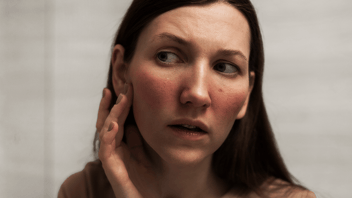
The journey through cancer treatment often involves more than just fighting the disease at a cellular level; it can also affect how individuals see themselves when they look in the mirror. Treatments, while essential, can lead to changes such as skin becoming less radiant, faces losing their fullness, and an overall appearance that may not feel like one's own.
These physical changes can challenge a person's identity and confidence, especially when strength and resilience are crucial. The struggle between maintaining one's inner strength and dealing with an altered external appearance can be a heavy burden.
Amid these challenges, personal stories of resilience and adaptation shine a light on the path to recovery and self-acceptance. If you're considering non-surgical facial rejuvenation, consult your oncologist first to ensure it's safe. Recently, Dr. Dayan worked with a patient, Lynn, who was undergoing cancer treatment for her triple-negative breast cancer diagnosis. "After being depressed for about a week, I thought, okay, if I'm going to do this, if I'm going to do the chemo treatments and the radiation treatments, I thought, I've got to look good while I'm doing it," explained Lynn. Her determination to maintain her appearance as a part of her battle with cancer reflects a powerful aspect of the healing process.
Lynn, who had already utilized aesthetic treatments as part of her regime, knew they could help her look and feel better. "I've lost my hair; I'm going to lose my eyebrows and eyelashes. When I go out, I don't want anybody to know I have cancer." Her story underscores the importance of addressing the visible signs of cancer treatment, not just for aesthetic reasons but for its profound impact on a patient's morale and determination.
What Kind of Facial Rejuvenation Is Possible During Cancer Treatment
Cancer treatments like chemotherapy and radiation often lead to skin issues, making it dry, thin, and sensitive as cells rapidly perish. Side effects like acne, flushing, and rashes can further exacerbate the discomfort of cancer therapies. Exploring non-surgical facial treatments, like fillers and peels, can offer a boost to those navigating the challenging cancer treatment journey. However, it's key to chat with your oncology doctor first to ensure these options are safe. Your health and safety are always the top priority.
Take Lynn's story, for example. Before considering any aesthetic treatments, her plastic surgeon, Dr. Dayan, made a call to her oncologist. They discussed Lynn's health and treatment plan to ensure that non-surgical options like fillers and neuromodulators would be safe for her. This step shows how important it is for your cancer care team and aesthetic specialist to work together.
This careful approach helps ensure that any facial rejuvenation steps are effective and fit well with your overall health. It's all about finding the right balance and getting the green light from your healthcare team.
So... what treatments are typically okay during cancer treatments
Lynn's Story
Chicago native Lynn, who was navigating the challenging waters of chemotherapy, decided to take a stand against letting her treatment affect her appearance. She sought out the expertise of Impressions Face + Body, where Dr. Dayan was ready with a strategic plan to rejuvenate her most affected features: the temples, cheeks, and jawline. By skillfully applying fillers and neuromodulators, Dr. Dayan restored volume to these key areas, directly combating the common side effects of chemotherapy, such as facial hollowness and an overall tired look. The carefully placed fillers in Lynn's temples provided an uplifting effect, revitalizing her facial expression. In the cheeks, the added volume brought back a healthy glow and vitality, while enhancements to the jawline sharpened and defined her contours.
Hyaluronic Acid Fillers During Cancer Treatment
Hyaluronic acid-based fillers stand out as a supportive option for those navigating the facial side effects of cancer treatments, particularly for individuals experiencing significant weight loss that leads to loss of facial volume.
- Restoring Lost Volume: Cancer therapies, such as chemotherapy and radiation, can lead to significant weight loss, which often manifests in the face as sunken cheeks, hollowed eyes, and an overall gaunt appearance. Hyaluronic acid fillers can counteract this by adding volume back to these areas, helping to create a fuller, more youthful facial contour.
- Smoothing Wrinkles and Fine Lines: The stress and physical toll of cancer treatment can accelerate the appearance of wrinkles and fine lines. Fillers can smooth out these signs of aging by plumping up the skin from within, leading to a smoother, more rejuvenated skin surface.
- Enhancing Symmetry: Treatment side effects might cause asymmetry in facial features due to uneven weight loss or muscle atrophy. Strategic placement of fillers can help balance and restore symmetry, contributing to a more harmonious facial appearance.
- Boosting Skin Hydration: Hyaluronic acid is known for retaining moisture. When used as a filler, it can enhance the skin's hydration levels, combating the dryness and flakiness often accompanying cancer treatments and leading to a healthier, more radiant complexion.
Collagen Stimulators During Cancer
Collagen stimulators like poly-L-lactic acid (PLLA) and calcium hydroxylapatite (CaHA) can be beneficial in addressing facial side effects commonly experienced by patients undergoing cancer treatments:
- Volume Restoration: Cancer treatments can lead to significant facial volume loss, giving the face a sunken or gaunt appearance. PLLA and CaHA stimulators encourage the body's natural collagen production, gradually restoring lost volume and creating a fuller, more youthful facial contour.
- Skin Texture Improvement: The skin can become rough, dry, or exhibit an uneven texture as a side effect of cancer therapies. These treatments can improve skin texture by stimulating collagen growth, making it smoother and more resilient.
- Reduction of Fine Lines and Wrinkles: Cancer treatments can fast-track aging signs like wrinkles. Collagen stimulators work to smooth these out by boosting skin elasticity and strength.
Dermal Fillers During Cancer
Dermal fillers can play a valuable role in addressing some of the facial side effects associated with cancer treatments.
- Restoring Volume Loss: One of the most common issues faced by patients undergoing cancer treatment is the loss of facial volume, leading to a sunken or gaunt appearance. Dermal fillers can effectively restore this lost volume, particularly in the cheeks, lips, and under-eye areas, helping to achieve a healthier, more youthful look.
- Smoothing Out Wrinkles and Creases: Cancer treatment can intensify the appearance of wrinkles and creases, particularly around the mouth, nose, and chin. Fillers can smooth these areas by plumping up the skin, reducing the visibility of these age-related changes.
- Enhancing Facial Contours: Treatment-related weight changes can alter the contours of the face. Fillers can help redefine these areas, such as the jawline and cheekbones, providing a more defined facial structure.
- Improving Skin Hydration and Texture: The hyaluronic acid in many dermal fillers has the innate ability to attract and retain moisture, which can improve skin hydration and texture. This is particularly beneficial for cancer patients whose skin may become dry and dull from their treatments.
HydraFacial's During Cancer Treatment
A HydraFacial, known for its hydrating, cleansing, and rejuvenating properties, can be particularly beneficial in addressing several facial side effects commonly associated with cancer treatments.
- Hydration: Cancer treatments often lead to dry, dehydrated skin. A HydraFacial deeply moisturizes the skin, helping to alleviate dryness and restore a hydrated, healthy glow.
- Gentle Exfoliation: The gentle exfoliation provided by a HydraFacial can help remove dead skin cells without irritating sensitive skin, improving texture and promoting a smoother complexion, which can be particularly beneficial for skin that has become rough or flaky due to cancer therapies.
- Reducing Appearance of Fine Lines: The hydrating serums used in a HydraFacial can plump the skin, temporarily reducing the appearance of fine lines and wrinkles that may be more pronounced due to the stress and side effects of cancer treatments.
- Minimizing Hyperpigmentation: Some cancer patients may experience changes in skin pigmentation as a side effect of treatment. The HydraFacial can help even out skin tone and reduce the visibility of hyperpigmentation spots.
- Soothing Irritation: The calming, soothing steps of a HydraFacial, including the infusion of nourishing serums, can help soothe skin irritation and redness often caused by cancer treatments.
- Improving Radiance: By cleansing, exfoliating, and hydrating, a HydraFacial can enhance the overall radiance of the skin, helping patients feel more confident and less impacted by the aesthetic side effects of their treatment.
Superficial Chemical Peels During Cancer Treatment
Treatments that hydrate, detoxify, and restore the skin can be safe and comforting, helping the skin appear more radiant and moisturized. Superficial chemical peels can be particularly beneficial in addressing several common facial side effects of cancer treatments by promoting skin renewal and improving overall skin appearance.
- Dryness and Flaking: Cancer treatments often lead to dry, flaky skin. Superficial peels help by removing the outermost layer of dead skin, promoting a healthier, more hydrated skin surface.
- Hyperpigmentation: Treatments like chemotherapy and radiation can cause changes in skin coloration, including dark spots. Chemical peels can lighten these areas by accelerating the turnover of skin cells, leading to a more even skin tone.
- Rough Texture: The skin's texture can become rough or uneven due to cancer treatments. The gentle exfoliation provided by a superficial peel can help smooth out the skin's surface, making it softer to the touch.
- Fine Lines: While not directly a side effect of cancer treatments, the stress and changes in skin care routines during treatment can accentuate fine lines. Superficial peels can help minimize their appearance by stimulating collagen production and promoting the growth of new, healthy skin cells.
- Acne and Breakouts: Some cancer treatments can lead to breakouts or worsen existing acne. By clearing out dead skin cells and unclogging pores, superficial peels can help reduce acne and prevent future breakouts.
Neuromodulators During Cancer Treatment
While not all neuromodulators are encouraged during cancer treatment, some can address facial side effects commonly experienced by cancer treatment patients.
- Relaxing Stress-Induced Wrinkles: The emotional strain of cancer treatments can lead to increased facial tension, contributing to deeper expression lines and wrinkles. Neuromodulators can relax these muscles, softening the appearance of stress-related lines on the forehead, around the eyes, and between the brows.
- Improving Facial Symmetry: Certain cancer treatments may cause muscle weakness or facial asymmetry. By carefully targeting specific muscles, neuromodulators can help restore a more balanced and symmetrical facial appearance.
Impressions Face + Body
At Impressions Face + Body, we aim to be more than just a place for cosmetic enhancement. We understand that looking good can profoundly impact feeling good, especially during difficult times like cancer treatment. It's not just about the physical changes; it's about lifting your spirit and boosting your confidence. Our team, led by compassionate experts like Dr. Dayan, is dedicated to supporting you in any way our team can.
Read On


Can You Have Surgery if You've Had Non-Surgical Procedures?
In recent years, the digital age and societal shifts, particularly highlighted during the pandemic,...

Can You Cover Up Eczema on Your Face?
Eczema isn’t fun to begin with. Add makeup or cover up to the mix, and it can get ten times worse....

